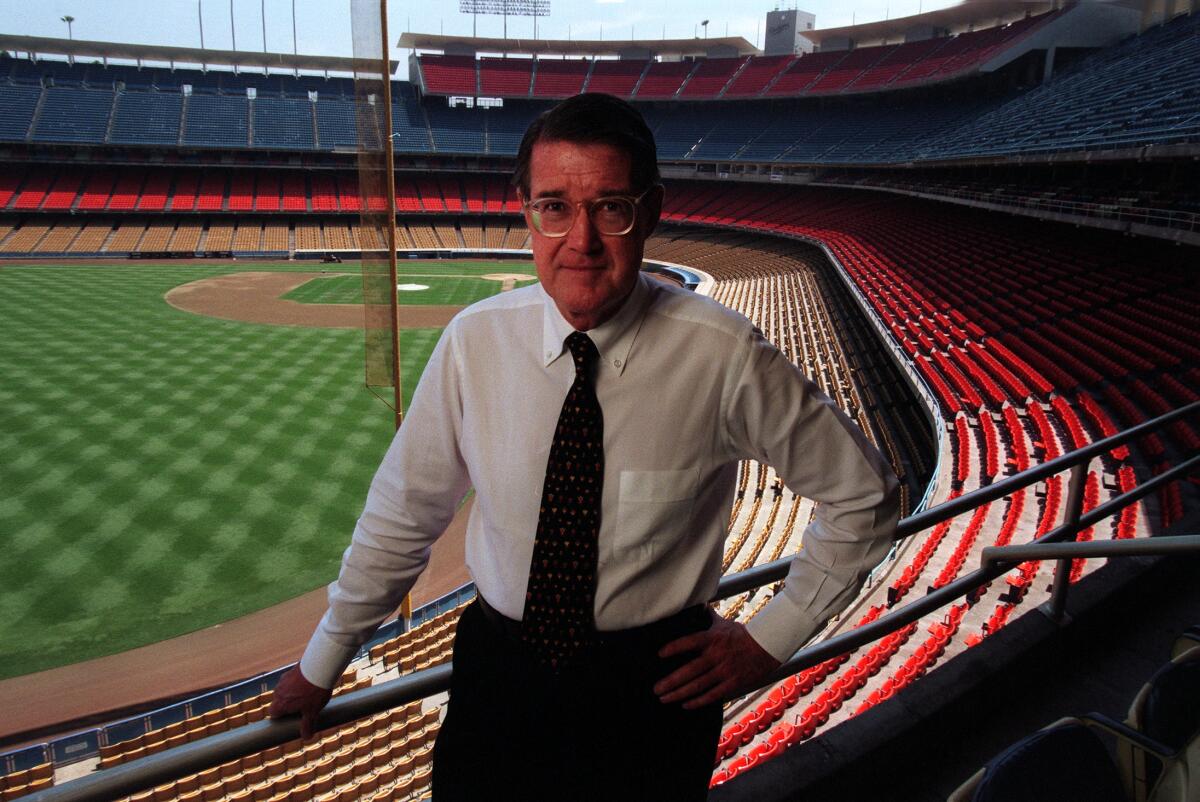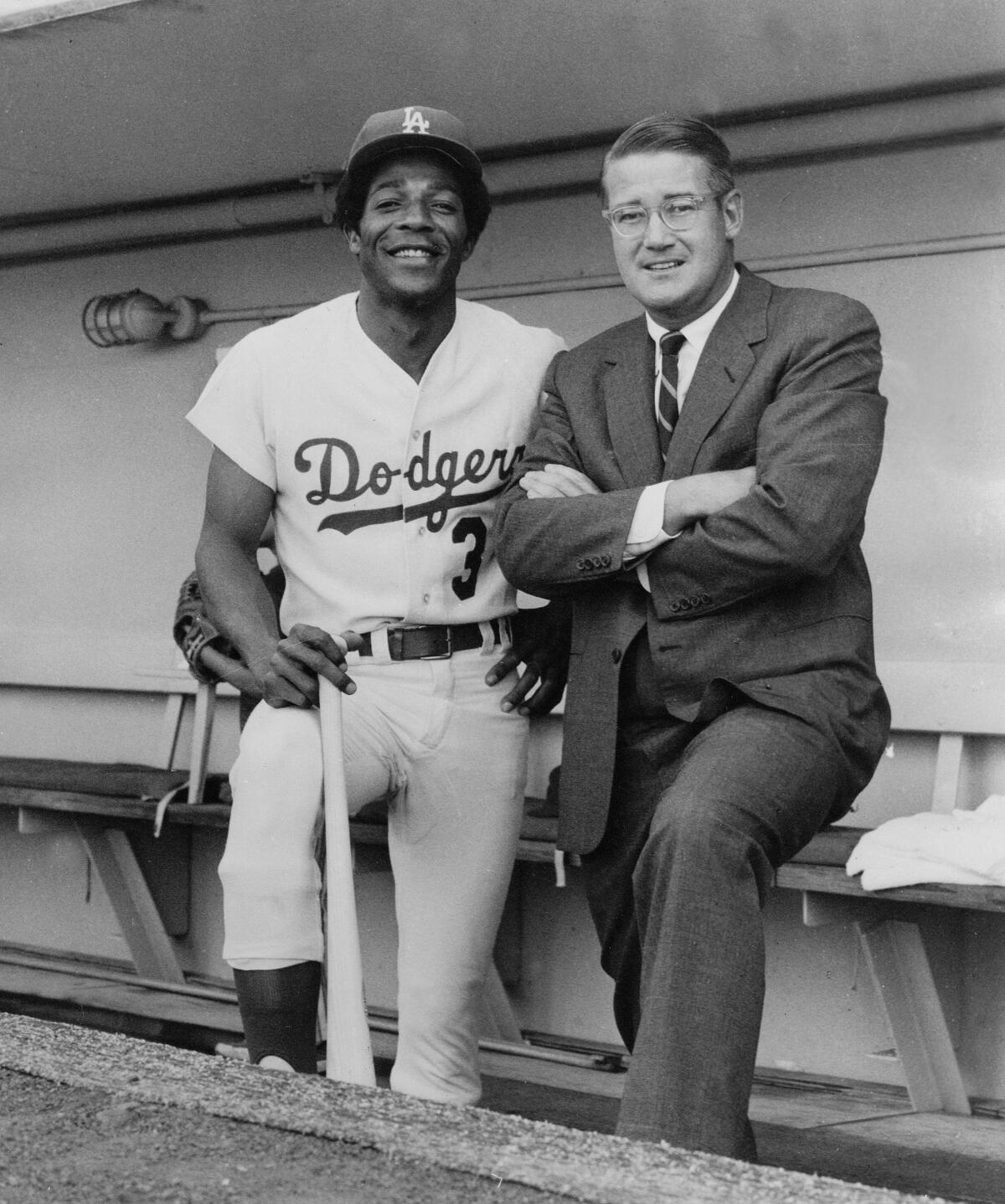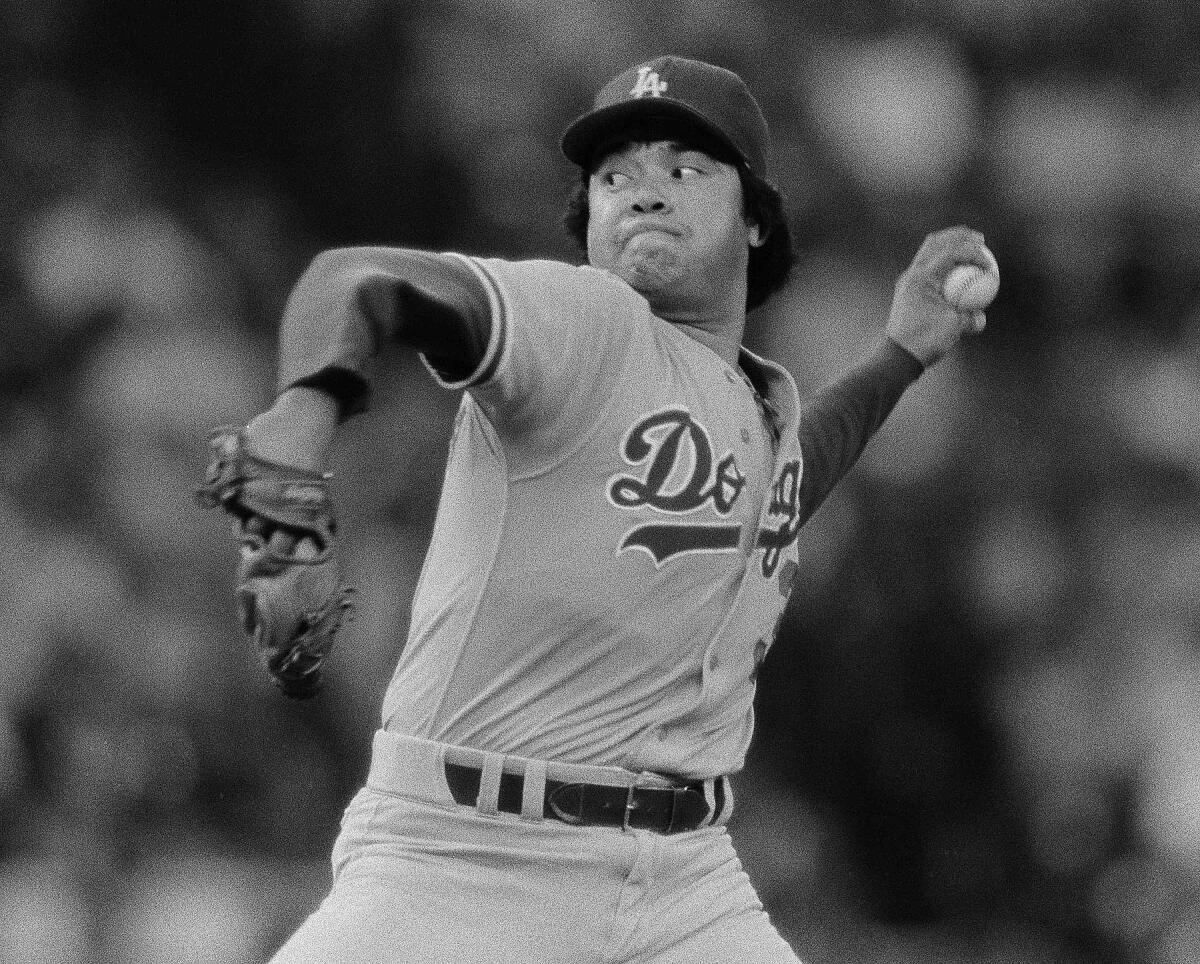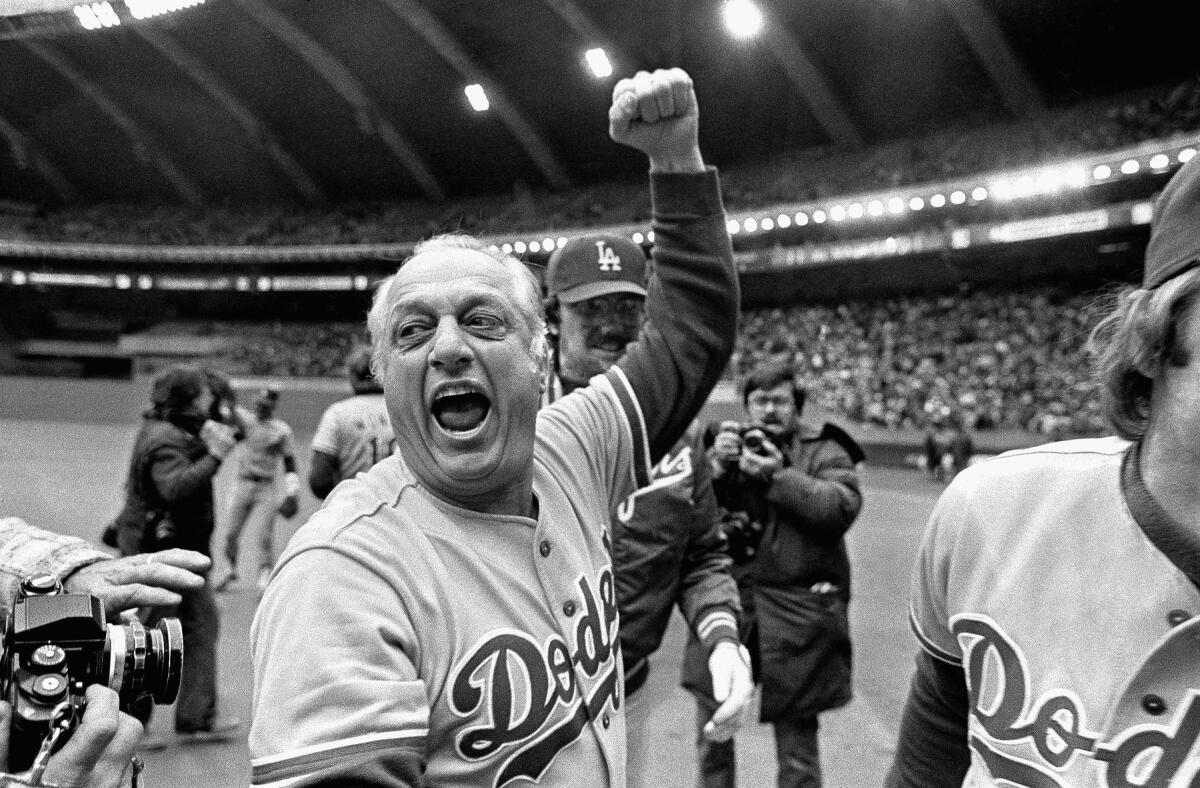Dodgers Dugout: Peter O’Malley answers your questions

- Share via
Hi, and welcome to another edition of Dodgers Dugout. My name is Houston Mitchell, and the Dodgers have gone 11-1 since going 5-15. They have won seven in a row. Of course, San Diego has won nine in a row and is a game in front of the Dodgers for first place. The Dodgers have the second best record in baseball. The Padres have the best record.
Former Dodger owner Peter O’Malley, who was involved with the team his whole life until selling the Dodgers in 1998, agreed a couple of weeks ago to take part in the “Ask....” series we do in this newsletter from time to time.
Are you a true-blue fan?
Get our Dodgers Dugout newsletter for insights, news and much more.
You may occasionally receive promotional content from the Los Angeles Times.
Readers sent me hundreds of questions, many of them variations of the same question (Why did you sell the team being a particular favorite), and I selected 17 to send to O’Malley. A tall order that would take some time, so I told him he could pick and choose which ones he wanted to answer. He answered all 17. And then he said if reader response to this first batch warranted, he’d be happy to answer some more.
He didn’t dodge (no pun intended) the tougher questions, he answered the easy ones and the hard ones.
So, without further ado, here are his answers. It’s long, but worth the read, so pull up a chair and spend some time with us.
The person listed as the questioner was the first person to send me that particular question.
Enjoying this newsletter?
Your support helps us deliver the news that matters most. Become a Los Angeles Times subscriber.
George Legg of Rolling Hills Estates: Which of the Dodger teams you were associated with ranks as your favorite?
O’Malley: Having worked for the Dodgers for approximately 37 years from 1961 to 1998, I was fortunate to get to know many talented and special players. Meeting them and their families at Dodgertown, Vero Beach, Fla. during spring training was a unique place to connect. Consequently rooting for a player or team became personal and we wanted all the teams to succeed, we strongly rooted for everyone. That was a constant every year with many highlights of course as well as disappointments. I thought the 1988 team not only accomplished more than anyone predicted, but it was truly a team effort where the reserve players (Stuntmen) played very significant roles and were enjoyable to watch and I think the fans agreed. Consequently, the short answer is the 1988 World Champion Dodgers.
Peter Hunt: Why did you decide to sell the Dodgers? and Daniel Navar: Do you ever regret selling the team?
O’Malley: My dad became president of the Dodgers in 1950 and I succeeded him in 1970 and the ball club was family owned by my sister Terry Seidler and myself from 1979 when our parents passed away until 1998 when Fox succeeded us. Before announcing our decision in 1997, we obviously gave the subject great thought. At that time player salaries began to escalate at a rate far in excess of income. Many teams started piling on debt and the prospect of doing the same for us was real. While most of the teams were losing money we were still in the black but it became more challenging. No one anticipated the huge spike in television revenue that lie ahead. I mention that because when we sold the team to Fox for $325 million and six years later when Fox sold the team for $430 million Fox was the largest television partner for baseball and apparently they also didn’t even see the extraordinary escalation in television revenue to follow. The fact that franchises now are trading for billions of dollars really does not give me any regrets. However, every day my dad and I were in our office at Dodger Stadium was a day we thoroughly looked forward to and totally enjoyed. I do miss the people in the organization as well as the players, coaches, announcers, trainers, stadium staff and everyone. All the memories are good.
Warren Maas of Chicago: Hello Mr. O’Malley. Before I get to my question, I want to thank you for being such a great owner during your years with the team. My childhood into young adulthood is filled with great memories that you and the Dodgers helped to create. I’m sure that I speak for many when I say that we miss you tremendously, even with the recent turnaround of the franchise.
My question is regarding the NFL stadium that you wanted to build on Chavez Ravine. How close do you think the project came to moving forward, would it have allowed you to keep the Dodgers, and do you have any regrets for not pursuing it a little more aggressively?
O’Malley: It was at 3:25 p.m., Tuesday, Aug. 22, 1995 when Mayor [Richard] Riordan called me. After exchanging pleasantries, he said, “Peter, we have a football problem in the city, do you have the space and interest for a football stadium on your property?” and I said Dick, I think the answer is yes to both questions. The next day I took Bob Graziano, Dodger chief financial officer, with me and the Mayor’s message was the same. I told him I would like to start seriously thinking about it. In the months following, I talked with community leaders, elected officials, NFL Commissioner Paul Tagliabue, President and Chief Operating Officer Neil Austrian, NFL Senior VP for League and Football Development Roger Goodell. I think it is fair to say that the more and more I met with the NFL executives and owners we bonded very well. The trust factor was established and there is no doubt in my mind that in those days our site was their most desirable one. We engaged consultants in all fields from architecture to traffic to parking to environment and even acousticians. We were making solid progress, but sadly some elected officials had other alternatives in mind. Our family invested more than $1 million in analyzing the concept to build a football stadium on our property. I was urged to carry on by the NFL and other interested parties, but when it was clear that the city representatives wanted us to shelve our plans I announced on October 18, 1997 with the headline in the Los Angeles Times that day “O’Malley backs off on NFL, Dodger owner says he will give Coliseum a little more time.” Again I was urged to put aside the city’s new view of the Coliseum when I concluded saying, “there comes a time when you can’t fight City Hall.” I strongly believe that the NFL had no interest in renovating the Coliseum but that fell on deaf ears. Now in respect to football and the Dodgers, I learned that all NFL teams were profitable whereas more than half Major League Baseball teams were losing money and I thought if the NFL would approve common ownership (our family with partners) the losses in baseball would be offset by the income of football until some day baseball became more profitable.
Jeanine Whitney: You were in college when your father made the historic decision to bring the Dodgers to Los Angeles and build Dodger Stadium. How much did he discuss that with you in those days?
O’Malley: Ebbets Field was built in 1913 and in the 1950’s while it was a charming, intimate baseball stadium it had really outlived its life expectancy. My dad became president of the Dodgers in 1950 and his number one priority was to privately finance a new stadium in Brooklyn replacing the aging Ebbets Field. He was confident he could arrange the financing and I am convinced he believed he would be successful building a new stadium. Our family’s website www.walteromalley.com has great detail on the subject. His first choice for a site was the intersections of Atlantic and Flatbush avenues in Brooklyn where the Long Island railroad terminated and all the subways in New York crossed. Assembling the land, which my dad understood he would pay for, proved more difficult than he thought it would be and his 10-year effort to keep the Dodgers in Brooklyn did not look promising. Coincidentally in 2004, the NBA and owner of the Brooklyn Nets chose that site for the Barclays Center housing the NBA team. That site was and apparently still is an extraordinary location for a stadium or arena. His critics have claimed that he never really wanted to keep the team in Brooklyn, he always planned to be in Los Angeles. That is not true and our files are very complete on this subject. It was only when he realized after many years he couldn’t make it happen in Brooklyn that he considered alternatives. It is interesting to me that when the National League owners approved the move of the Dodgers to Los Angeles my dad didn’t have a handshake on where to play just months later or when construction could begin on the new stadium. My dad didn’t shoot from the hip and believed in planning and I have always thought the move took a lot of guts. Yes, my parents did thoroughly discuss the move with my sister Terry and myself and I remember it well. We didn’t know anyone in the city of Los Angeles and all our friends were on the East Coast. When Dodger Stadium finally opened in 1962 my dad and his team, Captain Emil Praeger engineer, Jack Yount contractor and Vinnell Construction Company and Dodger Vice President Dick Walsh were all very happy about the result and the fans’ positive response.
Jon Clement: Huge Dodger fan from the Des Moines, Iowa area. I’ve been a fan of the Dodgers since I can remember watching baseball. I finally made a trip to St. Louis in High School to see the Cards play the Dodgers and been back every year but the pandemic. I still need to go to mecca and see the boys at Dodger Stadium.
Anyway, how do you feel about how the team is run now… Guggenheim, Friedman and Roberts?
O’Malley: The Dodgers are in good hands. While I haven’t gotten to know the Guggenheim executives, Stan Kasten, president, is a solid, sound, proven sports executive. I don’t know president of baseball operations Andrew Friedman but I have gotten to know Dave Roberts and I really like him both as a person and manager of men. The Dodgers will be in first place for a long time and it will be fun for all generations to follow the team in the years ahead.
Stuart Weiss: During your time as Dodger owner did you ever discuss roster moves with baseball side of the business (The GM, player personnel executives, coaches, scouts)?
O’Malley: Yes, I am a great believer in discussion. Learning what others think really helps identifying the right conclusion. I never hesitated to discuss all issues with both the front office and manager, coaches, scouts, etc. I don’t think at any time anyone was reluctant to tell me what they thought and I never hesitated to make it clear which way I wanted to go. No misunderstandings.

Kelvin Yamashita: What do you miss most about owning the Dodgers?
O’Malley: Without a doubt it’s the people and competitiveness. We were fortunate to have in the front office men and women who enjoyed their work and stayed with us a long time. I believe turnover is costly and providing an enjoyable, challenging environment is really important. I have often said that driving home after a game the experience of winning must far outweigh the disappointment of losing.
Rene Tellez of Los Angeles: What is your first memory of baseball/Dodgers, the family business?
O’Malley: Looking back I clearly remember going to Montreal with my dad to watch our triple-A Montreal farm team playing in the year 1946 and in 1947 going to Cuba with my family when the Dodgers spent spring training in Havana which was an early insight to the family business. My first job out of college in 1962, I managed the spring training facility Dodgertown in Vero Beach. It was then the remains of the old Navy air barracks and my job was significant: Opening the facility the first of the year, staff it, run it and close it down in April. In years when I was president and general manager of the Spokane Indians farm team in the Pacific Coast League, I was introduced to all the issues on a very small scale that lay ahead at Dodger Stadium. That was a great experience and I thank the people in Spokane for welcoming me so warmly.
Ron Sokol of Manhattan Beach: First, gratitude to you and your family for the Dodgers, for your contributions to baseball, and to the overall betterment of the community here in Los Angeles and elsewhere. Noted and appreciated.
My question is how do we address the concerns and contentions made about the building of Dodger Stadium? Some say that various people were displaced, that it was unfair, in fact it was unjust, a “taking” of property that displaced families and thus was callous. I would appreciate your perspective on it so that I can finally have a real sense of what happened and what is true.
O’Malley: I really appreciate the question because unfortunately the history of Chavez Ravine and the Dodgers has been often inaccurately told.
In late 1949 and early 1950, plans were developed to construct a federal housing project in Chavez Ravine and residents were notified at that time that they would have to vacate their properties. They were to be given the first right to return to “Elysian Park Heights” once the federal housing project was built. By 1951, properties were independently appraised and residents compensated.
By then, 99% of the homeowners vacated through eminent domain proceedings. In 1952, voters in Los Angeles rejected the idea of a public housing project in a city-wide referendum. A new mayor was elected who did not support public housing in 1953 and the project ceased. In 1954, the city purchased the land from the Housing Authority, but it lay dormant for years as elected officials were unable to determine a use for the extremely hilly and rugged terrain – although a cemetery, zoo, state college and man-made lake were considered.
In those years, my Dad was solely focused on his unprecedented 10-year effort to remain in Brooklyn and privately build a new domed stadium for the Dodgers and had never heard of Chavez Ravine. Years later, in 1957, the City of Los Angeles hired respected business leader Chad McClellan to negotiate a contract with the Dodgers. That led to obligating my Dad to privately building and maintaining a 50,000-seat stadium. The land was put on the tax rolls for the first time in many years, a large consideration compared to “municipally-owned” stadiums. Also, under the terms of the contract the Dodgers paid $500,000 to develop a youth recreation center with additional $60,000 annual payment for 20 years. The city and county built infrastructure roads from the stadium to freeways. In exchange, the City of Los Angeles received Wrigley Field in Los Angeles, then valued at $2.2 million.
Interestingly, in June 1958 when Los Angeles residents were asked to vote on Proposition B, to approve the city’s contract with the Dodgers, the heavily-Latino ninth council district (which included Chavez Ravine) voted yes by more than a two to one margin.
In May 1959, in order to clear the land for Dodger Stadium, the last handful of residents, who were living on city-owned property and not paying for services, had to be removed by the city and county; they had refused to leave and relocate despite repeated eviction notices from the City of Los Angeles. The city should have relocated that small group of residents long before it was time to break ground for Dodger Stadium.
More details are available at walteromalley.com here: https://www.walteromalley.com/en/features/chavez-ravine/Overview
Nick Mrvos: What do you think of the changes made to Dodger Stadium?
O’Malley: All the reports I have heard about the fan-friendly enhancements at Dodger Stadium are positive. I have not visited the stadium since the pandemic and plan to go there next homestand. The extraordinary vision and design of the stadium has not been impacted while new sources of revenue have been integrated. Dodger Executive Vice President, Planning and Development Janet Marie Smith is without a doubt the leading authority on new stadiums and renovations and she deserves a lot of credit.
Jonathan Marmor of Seattle: In 1975, I nearly fell out of my chair when the Dodgers signed Juan Marichal. Given the history Marichal had with the Dodgers, that transaction caught me by surprise. Could you talk about that signing? I am also curious how Marichal was received by the players.
O’Malley: Good question, it reminds me when the Brooklyn Dodgers acquired former New York Giants pitcher Sal (the Barber) Maglie in 1956. Prior to that, Maglie was extremely unpopular in Brooklyn primarily for his high-inside style of pitching to Carl Furillo, Dodgers outfielder. That’s how he got the name “the Barber.” Furillo was one of Sal’s favorite targets. To everyone’s surprise when Sal walked into the Dodger clubhouse the first one to greet him was Carl and they became close friends. The Juan Marichal/John Roseboro incident was a very regrettable, emotional moment. However, in an effort to improve the Dodgers pitching staff, we acquired Marichal near the end of his Hall of Fame career. Tommy Lasorda saw him pitch in the Dominican Republic and thought he might be able to help us, but after a few starts he experienced back problems ending his short comeback try. Keep in mind pro athletes respect talent and the Dodger players respected what Marichal had accomplished. Fortunately, he and Roseboro connected and became good friends as the years went by. I watched that happen and since they were both good friends of mine I was glad the story had a happy ending.
David Johns: What are your thoughts on the defensive shift, and of the runner on second to start extra innings?
O’Malley: I really haven’t followed the defensive shift and starting extra innings with a runner on second base but I am glad baseball is listening to the fans and trying different things. It reminds me of 1973 when Oakland Athletics owner Charlie Finley made some suggestions such as curved foul lines and orange baseballs. Those ideas didn’t get very far but the introduction of the designated hitter in the American League in 1973 has proven popular with American League fans and will probably be adopted by the National League in the next negotiation with the Players’ Assn.
Pete Stephenson: What is your current involvement with the Padres, and is it tough for you when the Padres and Dodgers play each other?
O’Malley: I am not involved with the Padres but when asked a question, I’m happy to respond. Having worked for the Dodgers for 37 years I can never root against the Dodgers but at the same time my nephew Peter Seidler is the majority owner and CEO of the Padres. Of course our family roots for the Padres and we look forward to the day when they win their first World Series championship. Now if it were the ninth inning in the final playoff game between the Dodgers and the Padres to determine who represents the National League in the World Series and I was at the stadium I am not sure what I would do and will have to wait for that special moment.

Elliot Matheson: Would you retire Fernando Valenzuela’s number if you still owned the team?
O’Malley: On my watch we established the policy to retire the numbers of our players who had been elected to the Baseball Hall of Fame. The Dodgers have been fortunate to have many extraordinary players but I think the policy is sound. In 1978 when we were about to begin the World Series I made the decision to honor Jim Gilliam who had not been recognized by the Hall of Fame. Sadly, Jim had a cerebral hemorrhage, went into a coma and passed away suddenly two days before the World Series. Jim Gilliam, Johnny Podres and Sandy Koufax are the only three Dodgers to play for four World Series championship teams. Of all our players I don’t think anyone was more recognized as a player who sacrificed himself for the good of the team, he was selfless. That attitude was also recognized by opposing players and was a well-deserved tribute to Jim. Jim’s #19 is not retired because of his statistics but because he brought so much to the Dodger organization throughout his career as a player and coach. To this day, Jim is constantly remembered by those who had the good fortune to know him because of his strong belief that the team’s success is more important than the individual’s.
Fernando’s impact on the organization, the city and all of baseball was historic and monumental. Fernandomania was one of the most enjoyable times for me. He has always been a significant representative of the Dodger organization and I am sure he’ll be recognized most appropriately. 2021 is the 40th anniversary year of Fernandomania and he deserves all the tributes that the organization and fans are putting together.

Bryan Beban of Eugene, Ore.: When Walter Alston retired in 1976, was there an active search to replace him as manager or was Tommy Lasorda simply elevated? Were any other candidates interviewed?
O’Malley: Tommy Lasorda was the obvious choice to follow Hall of Fame Dodger manager Walter Alston. He was well known to everyone in the organization from the days he pitched in the minor leagues to his scouting to managing our farm teams to third base coach under Alston. I thought Tommy handled the constant inquiries about when he would be the manager very well. I never promised him that he was the heir apparent but fortunately we were good friends from the very earliest days. I traveled to the Dominican Republic to see him manage winter ball, to Ogden, Utah, where he managed a rookie team, to Spokane, Wash. where he managed our triple-A team and our relationship was very honest and frank. When Tommy was asked how difficult it might be to follow the legendary Walter Alston his reply was “no problem, but the guy following me will have a big challenge.”
RG Batlett of Fair Oaks: Considering the O’Malley’s long and storied history with professional baseball, was there a period of time that you look back on most fondly or recall most vividly?
O’Malley: There were many moments and periods in time that our family is fortunate to remember most fondly, but I really think the answer is spring training each year. Dodgertown was the Dodgers spring training site from 1948 to 2008. In the early years, we occupied the remaining Navy air barracks that were constructed during the war and over time when we bought the property, we built Holman Stadium, living accommodations, dining room, clubhouse, kitchen, offices, meeting rooms, additional fields, etc. It was truly like a small college campus with everyone living on site and walking from one place to the other so it was natural that friendships and bonding began. That was critically important since spring training set the stage for opening day, bringing everyone together for the season to follow. If you were to ask 100 players, wives, staff members, press people, etc., I think the overwhelming majority response would be Dodgertown worked and everyone enjoyed being there. The residents of Vero Beach in Indian River County deserve a lot of credit for helping to create this special feeling – keep in mind in the 1960’s the population of Vero Beach was only 8,800. Today, Major League Baseball is responsible for the property, now called the “Jackie Robinson Training Complex,” which is a year-round, multi-sport site, for its amateur development programs and diversity initiatives to strengthen the pipeline of top talent by developing skills and elite playing opportunities for boys and girls around the country. I continue to go there several times a year and it is still a unique and very special place.
Glenn Oshima: How was the Dodgers organization able to maintain the same ticket pricing structure for such a long period of time? I was surprised back then, and still am today, how the seat prices for the field boxes, loge, reserved, and general admission were held to the same amount for so long.
O’Malley: Yes, from 1958-1975 Dodger Stadium ticket prices were unchanged, that is historic. Our family really appreciated the widespread support of Los Angeles with many families of all ages in attendance. Our goal was to provide a clean, safe stadium. We had no debt or partners in ownership and maximizing profit for every dollar was not something we wanted to do. Free agency resulted in higher player salaries and I don’t blame the players or their agents for getting whatever they could. As a result, around that time, ticket prices in the industry escalated. Owners only give players higher and higher contract terms because they could afford it and that’s true to this day. When I see players receiving several hundred million dollar guaranteed contracts I say to myself the owners would not be doing it if it wasn’t a good business decision. Fortunately, the game is still the most attractive form of entertainment and the future is bright.
Postponement
It is time for my annual summer vacation. You may be asking “Why does the Dodgers newsletter guy take a vacation during the middle of the season?” Well, good question. It’s the only time all the family can get together, and, since we didn’t do anything last year during the height of the pandemic, we are all going to enjoy 10 days or so this year when we can all be together. I’ll be back with a new newsletter on June 7 or so.
Up next
Tuesday, Dodgers (*Clayton Kershaw, 6-3, 3.18 ERA) at Houston (Zack Greinke, 4-1, 3.77 ERA), 5 p.m., Sportsnet LA, AM 570
Wednesday, Dodgers (Trevor Bauer, 5-2, 1.98 ERA) at Houston (Luis Garcia, 2-3, 3.38 ERA), 4:30 p.m., Sportsnet LA, AM 570
Thursday, San Francisco at Dodgers, 7 p.m., Sportsnet LA, AM 570
Friday, San Francisco at Dodgers, 7 p.m., Sportsnet LA, AM 570
Saturday, San Francisco at Dodgers, 4:15 p.m., Fox, AM 570
Sunday, San Francisco at Dodgers, 1 p.m., Sportsnet LA, AM 570
*-left-handed
And finally
Vin Scully talks with Walter O’Malley after the 1965 World Series. Watch and listen here.
Until next time...
Have a comment or something you’d like to see in a future Dodgers newsletter? Email me at [email protected], and follow me on Twitter at @latimeshouston. To get this newsletter in your inbox, click here.
Go beyond the scoreboard
Get the latest on L.A.'s teams in the daily Sports Report newsletter.
You may occasionally receive promotional content from the Los Angeles Times.




